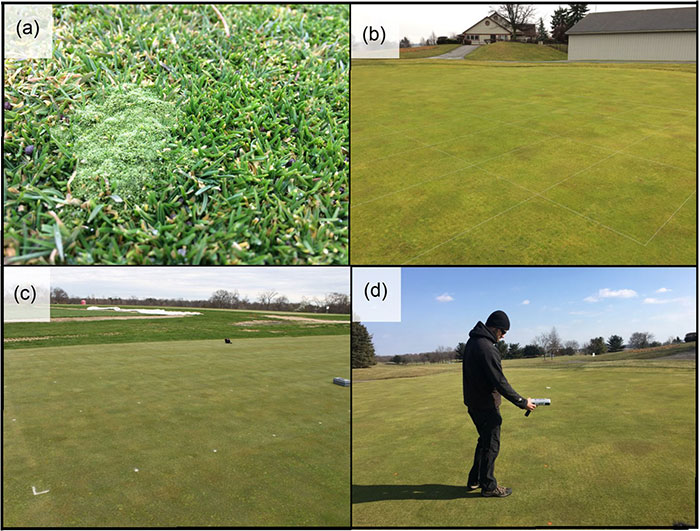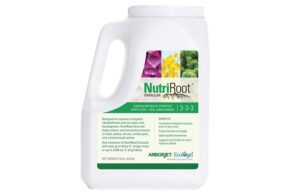Research identifies sand and topdressing needed to manage putting greens
The second part of this USGA Green Section article reviews a combination of field observations and recent research, which shed new light on the type of sand and quantity of topdressing needed to manage thatch and organic matter accumulation in putting greens. Click here to read the first part of this article.
Will topdressing with two different sand materials cause poor water infiltration or increase soil moisture retention?
Researchers at Rutgers University are experimenting with topdressing sand much finer than described in this article to investigate whether there would be any negative impact on a creeping bentgrass green (Murphy et al., 2019). The finest material used in this study contained 69 percent fine sand (0.15-0.25 mm) and was referred to as the fine-medium sand in Table 1. The medium-fine sand contained 23 percent fine particles and 77 percent medium particles, and the medium-coarse sand contained only 8 percent fine particles and 58 percent medium particles.
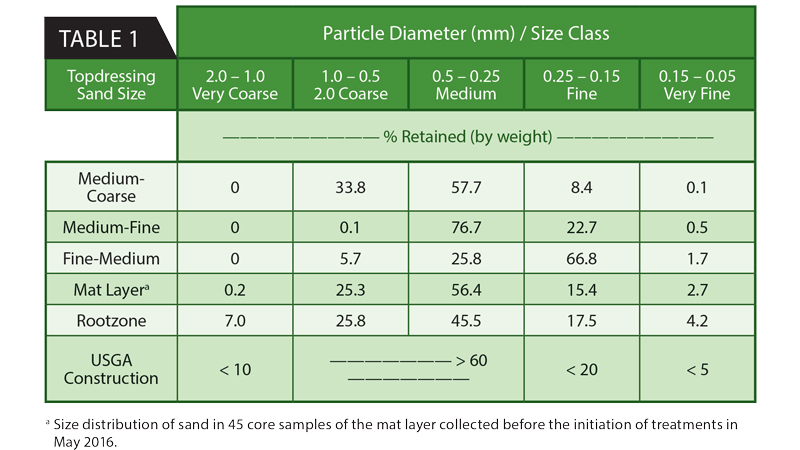
Sand size distributions of the three topdressing sizes, mat layer and the underlying rootzone at the initiation of the experiment; USGA construction recommendations provided for reference (reproduced from Murphy et al., 2019). (Photo courtesy of Brian Whitlark)
Although soil moisture content has increased with the fine-medium sand compared to topdressing with coarser materials, plots topdressed with the fine-medium sand have had lower soil moisture content when compared to plots that have never been topdressed. Furthermore, when core aeration is applied to the fine-medium topdressed plots and aeration holes are filled with the medium-coarse sand, the infiltration rate and soil moisture retention have been similar to that of the plots topdressed with coarser materials and not core aerated. Therefore, the preliminary results of this research indicate that topdressing with a much finer material than described in this article is better than no topdressing at all.
Additionally, any reduction in infiltration rate associated with using the finer sand can be offset by aeration and filling the holes with a coarser material. This Rutgers study is confirmation for superintendents using two different sand materials for topdressing greens — one for routine topdressing and a coarser material that matches the existing rootzone to fill holes following aeration.
For the management of ultradwarf bermudagrass greens, a current study conducted at Texas A&M University is evaluating the impact of sand topdressing with fewer coarse particles than that used to construct the greens (McInnes et al., 2019). Researchers are using rootzone characteristics such as sand particle size, organic matter content and bulk density from multiple greens on nine golf courses to predict soil moisture content and field-measured infiltration rate.
Modeling efforts are ongoing, but some information can be gleaned from preliminary data. As expected, the infiltration rate generally decreases with decreasing particle size and increasing organic matter content, though there are outliers. Even so, the infiltration rate of the majority of sampled greens meets or exceeds the minimum recommendation of 6 inches per hour, and the putting greens are performing well.
These preliminary results indicate that desirable infiltration rate and surface moisture content can be maintained with the use of medium-graded topdressing sands.
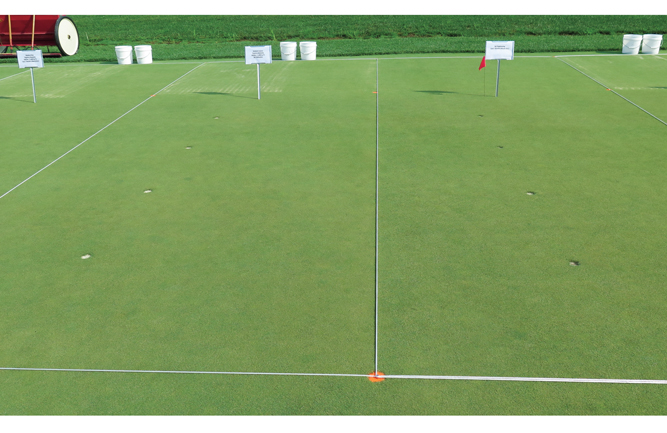
The medium-coarse sand topdressed plot on the left has significantly better turf density and lower surface moisture than the core-aerated, nontopdressed plot on the right, which has a darker green color due to surface algae. (Photo courtesy of Brian Whitlark)
Why remove the larger sand particles?
Large sand particles create playability and mower problems. A Rutgers University study on creeping bentgrass putting greens revealed that the particle size of the topdressing sand significantly impacted the size of the sand harvested in mower baskets when mowing the day after topdressing (Murphy et al., 2019). On average, approximately 60 percent of the sand in mower baskets fell in the coarse sand fraction (greater than 0.5 mm) when using the medium-coarse sand (the medium-coarse sand contained approximately 34 percent coarse particles and 58 percent medium-sized particles) for topdressing.
By comparison, less than 10 percent of the sand found in mower baskets consisted of coarse particles when topdressing with the medium-fine sand (0.1 percent coarse particles and 77 percent medium particles). So, the coarser the sand, the more sand will be harvested by the mower. The particles picked up will also be the larger-sized particles — those that have the greatest impact on playability and mowing equipment.
Interestingly, the Rutgers study, as well as two recent studies at Michigan State University and the University of Tennessee (Strunk et al., 2018; Dickson et al., 2019), found that mowers collect 1 to 5 percent of the sand in a single mowing one or two days after topdressings. More sand will be harvested with subsequent mowing, especially if topdressing occurs every few weeks, as recommended in this article. The fact remains that applying larger sand particles will lead to more sand harvesting by mowers, increased equipment maintenance and more negative impact on the putting surfaces.
Application rate and frequency
There are two important rates to consider in a topdressing program: the sand application rate for each top dressing event and the annual rate achieved from the sum of all topdressing events, including sand applied to backfill aeration holes. The rate for an individual event must be considered simultaneously with application frequency because these factors are inversely related. As application frequency increases, the topdressing rate needed for each application decreases. The benefits of lighter rates include ease of application and incorporation, as well as reduced mower wear.
Perhaps the greatest benefit is less disruption to the playing surface when compared to heavier sand application rates. In fact, one can argue that greens will be putting greens on 104 different U.S. golf courses. They determined that putting greens receiving at least 20.3 cubic feet of sand per 1,000 square feet per year accumulate less organic matter (Schmid et al. 2014a) than courses topdressing with lower annual amounts.
In a related experiment, the same research group tested the effects of various cultivation strategies on organic matter accumulation but observed no differences among cultivation treatments (Schmid et al., 2014b). All cultivation treatments in the study, including an uncultivated control, received 22 cubic feet of sand per 1,000 square feet per year, and the researchers concluded that the benefits of their topdressing program partially limited their ability to detect differences among cultivation treatments.
Trends observed by USGA agronomists suggest that 25 to 35 cubic feet of sand per 1,000 square feet per year is a good annual target to adequately dilute organic matter. Depending on the other factors described below, more or less than this range may be appropriate.
Why the disparity between current research and industry trends? The answer to this question is complex. The basic premise is that the 20.3 cubic feet of sand per 1,000 square feet per year from survey data is essentially an average of the minimum annual rate that was related to lower organic matter concentrations among golf courses. This amount is an average from 104 golf courses in 14 states with diverse turf maintenance programs. Optimal annual topdressing rates don’t directly translate across golf courses, especially across different regions.
Optimal topdressing rates are most dependent on the length of the growing season and the quality of the growing environment. The turfgrass species and cultivar, nitrogen fertilization program and traffic intensity also determine how much sand is needed to offer a better playing surface on the day of topdressing if the right sand is applied at a light rate.
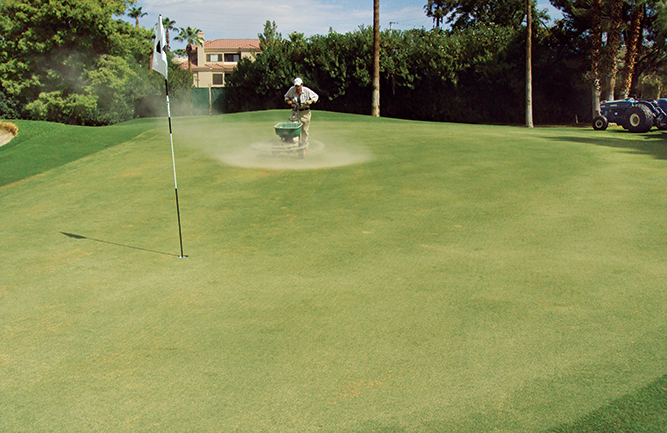
Light topdressing rates of 0.50 to 0.75 cubic feet of sand per 1,000 square feet are used during periods of minimal growth. (Photo courtesy of Brian Whitlark)
Annual targets
Planning to reach a predetermined amount of sand for the season is a good place to start with rate and frequency considerations. The goal is to match the growth rate of turf to dilute organic matter that accumulates throughout the season. In search of a benchmark, researchers from the University of Nebraska surveyed 308 annually. Turfgrass growing in an ideal environment over a long season with plenty of nutrition and few stresses, like shade and traffic, will produce more organic matter and subsequently require more topdressing. However, turfgrass under stress for any reason or grown over a shorter season will require less annual topdressing.
Regarding species, 79 percent of surveyed superintendents who have converted putting greens from creeping bentgrass to ultradwarf bermudagrass report using more sand with ultradwarf bermudagrass (O’Brien and Hartwiger, 2014). So, an annual rate of 20.3 cubic feet is a starting point and may be sufficient in some situations. However, in other settings, more sand is typically required on an annual basis to mitigate organic matter accumulation.
The importance of frequency
Around the turn of the 21st century, a standard topdressing strategy was to apply 2 to 4 cubic feet of sand per 1,000 square feet every three to four weeks during the growing season (Rieke, 1999). Lower rates and higher frequency were recommended for high-density cultivars or stressed areas. However, the previously mentioned survey data show that surveyed golf courses that cultivated at least twice a year and topdressed every seven to 14 days had lower organic matter concentrations (Schmid et al. 2014a). Topdressing every seven to 14 days also is more common in successful ultradwarf bermudagrass putting green management programs (Lowe, 2013; O’Brien and Hartwiger, 2014). To follow these recommendations, what topdressing rates would be required to reach the annual topdressing guideline of 25 to 35 cubic feet of sand per 1,000 square feet per year?
First, we should account for sand incorporated during aeration. An estimated 5 to 7 cubic feet of sand per 1,000 square feet is required for backfilling aeration holes, depending on overall surface disruption from tine size, spacing and depth. Given this, a golf course that backfills two aerations annually could apply 14 cubic feet of sand per 1,000 square feet during aeration.
During a 30-week growing season, assuming light topdressing is withheld the weeks immediately before and after aeration, 16 more cubic feet of sand per 1,000 square feet still would be needed over the remaining 24 weeks to reach 30 cubic feet per 1,000 square feet for the season (the middle of the suggested range). If remaining topdressing applications were conducted weekly, only 0.67 cubic feet of sand per 1,000 square feet would be required each week. The necessary rate would increase to 1.23 cubic feet per 1,000 square feet with a 14-day topdressing schedule (Figure 1).
It’s often most manageable to determine a rate and frequency for each topdressing event based on annual goals and stick with that plan unless adjustments are needed to match growth and organic matter accumulation. A rate of 0.5 to 1.5 cubic feet of sand per 1,000 square feet is generally a good range. Rates will likely be on the higher end during higher growth periods and lower when growth slows or when the turf is stressed. A good rule of thumb is to delay a scheduled topdressing or reduce the planned rate if significant sand is still visible from the prior application.
In situations where the soil profile is already ideal, some superintendents effectively manage organic matter only with frequent topdressing and no core aeration. In the absence of core aeration, it is critical that golf courses meet or exceed the annual guideline of 25 to 35 cubic feet of sand per 1,000 square feet.
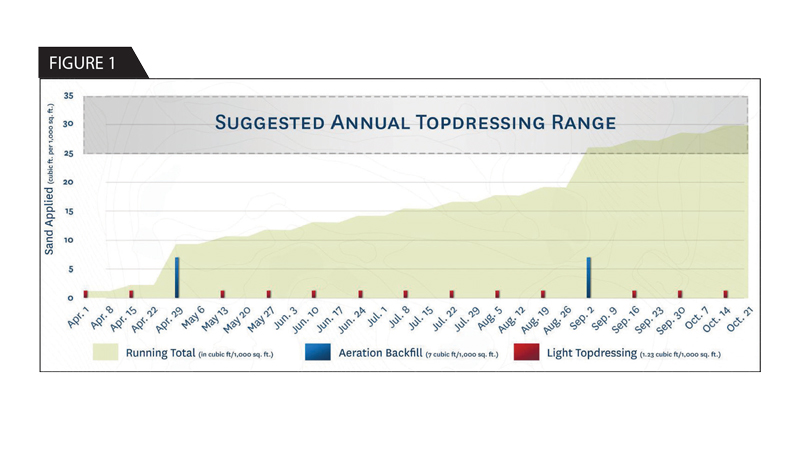
An example of a light, frequent topdressing program designed to achieve an annual topdressing rate of 30 cubic feet per 1,000 square feet for a course with a 30-week growing season. The suggested annual topdressing range (gray box) is based on off-field observations and research for both cool- and warm-season putting greens. (Photo courtesy of Brian Whitlark)
Light sand topdressings can be effectively brushed, rolled or irrigated into the turf canopy. Still, recent research has shown that mowing practices affect sand harvesting even with brushing after topdressing. Backtrack mowing — i.e., two passes in opposite directions over the same area — at a standard frequency of clip or increasing the frequency of clip during a single pass, harvested the most sand following topdressing on both creeping bentgrass and ultradwarf bermudagrass putting surfaces (Strunk et al., 2018; Dickson et al., 2019).
Cross-cutting — i.e., mowing a putting green twice in perpendicular directions — at a standard frequency of clip also collected more sand than a single pass at a standard frequency of clip in the ultradwarf bermudagrass study, but not in the creeping bentgrass study. As a result, backtrack mowing and increasing the frequency of clip should be avoided following topdressing to reduce sand harvesting and wear on mowers. Additionally, it is helpful to note the amount of sand collected and adjust topdressing rates or incorporation practices if necessary.
Conclusion
Sand topdressing is the most important cultural practice for managing the organic matter. Recent research confirms the benefits of light and frequent sand topdressing programs that provide less immediate disruption, better playing conditions and better rootzone characteristics over time. It is critical to assess putting green performance and the quality of the rootzone to determine if circumstances warrant an accelerated program for improvement beyond what is possible with light and frequent topdressing.
Regardless of the selected topdressing program, silica sand is preferred because of its tolerance to weathering. Aeration backfill should closely match the physical characteristics of the sand used at construction, but routine topdressing sand can be somewhat less coarse to ease incorporation and reduce wear on mowers. Ongoing research suggests that this will not impede infiltration or cause an overly wet surface. Regardless of the selected topdressing program, it is wise to assess rootzone physical properties regularly by submitting core samples to a soil-testing laboratory.
Research takeaways
- Sand topdressing is the most important cultural practice for managing organic matter.
- Recent research confirms the benefits of light and frequent sand topdressing programs that provide less immediate disruption, better playing conditions and better rootzone characteristics over time.
- It is critical to assess putting green performance and the quality of the rootzone to determine if circumstances warrant an accelerated program for improvement beyond what is possible with light and frequent topdressing.
- Regardless of the selected topdressing program, silica sand is preferred because of its tolerance to weathering.
- Aeration backfill should closely match the physical characteristics of the sand used at construction. Still, routine topdressing sand can be somewhat less coarse to ease incorporation and reduce wear on mowers. Ongoing research suggests that this will not impede infiltration or cause an overly wet surface.
- Regardless of the selected topdressing program, it is wise to assess rootzone physical properties regularly by submitting core samples to a soil-testing laboratory.
This article originally appeared in the May 2019 issue of the USGA Green Section Record.










